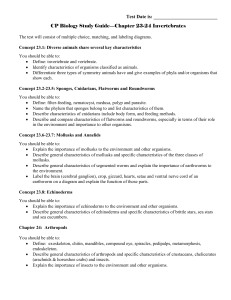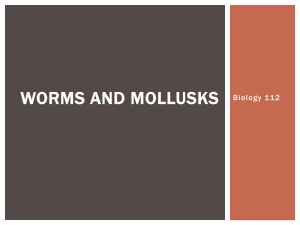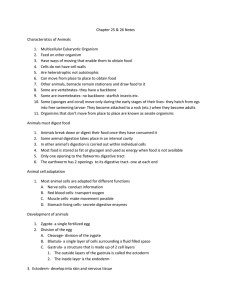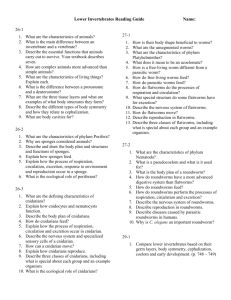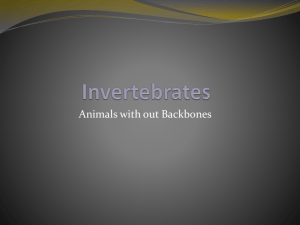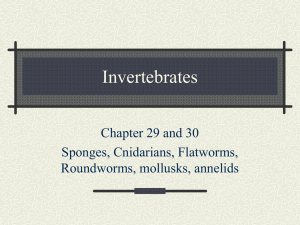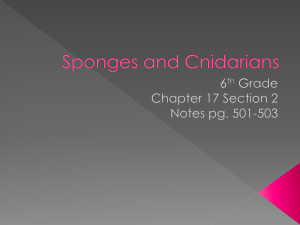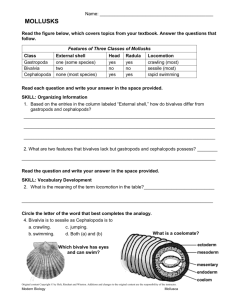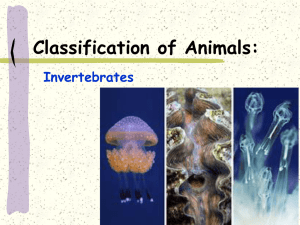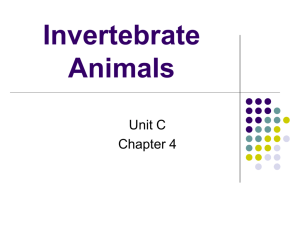Sponges cnidarians worms mollusks
advertisement
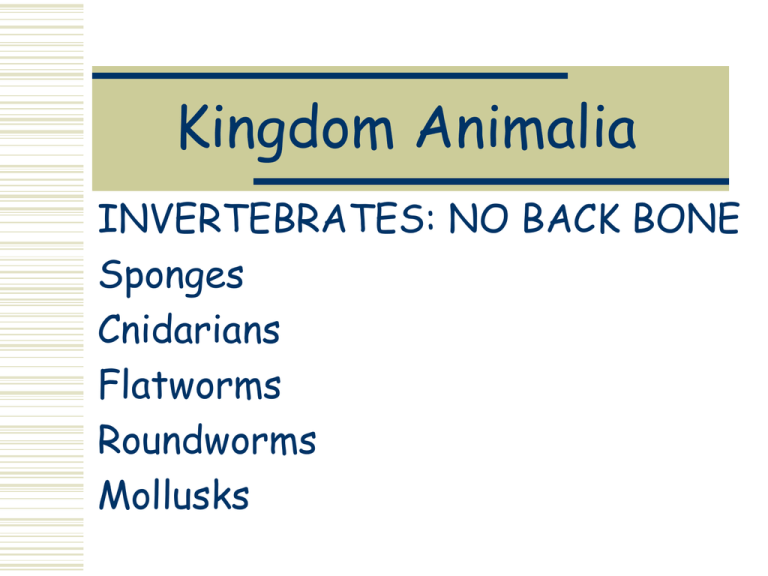
Kingdom Animalia INVERTEBRATES: NO BACK BONE Sponges Cnidarians Flatworms Roundworms Mollusks Sponges Assymetrical: similar parts regularly arranged around a central axis Freshwater or saltwater Sessile – do not move Filter feeders: filter food out of the water Body covered with many pores (openings) Sponges All cells function independently Some produce spicules: thin, spiny structures that form the endoskeleton Some produce soft fibers as a skeleton These are the ones people use Sponge Reproduction: Asexually –budding Sexually – joining of sperm and egg Other Sponge Facts: Sponges can regenerate – replace lost body parts through mitotic cell division. Commercial sponge harvesting for personal care industry. Used as medicines Cnidarians – Stinging Animals Radial Symmetry: similar parts regularly arranged around a central axis Hollow central cavity with 1 opening called a mouth Cnidarians – Stinging Animals 2 body types: Polyp: vase shape that doesn’t move Medusa: umbrella shape that moves around Cnidarians – Stinging Animals Mostly saltwater Corals Jellyfish Sea anemones Hydra Feeding Use tentacles to capture food. Tentacles have NEMATOCYSTS – stinging cells that grab and immobilize prey using toxins. Waste products and undigested materials are expelled through the mouth. Organization Nerve net – conducts impulses from all parts of the body. No brain. Two layers of tissues derived from endoderm and ectoderm Cnidarian Reproduction Asexually – budding (polyp form) Sexually –produces egg and sperm Flatworms Platyhelminthes Bilateral Symmetry: body the same on both sides Acoelomate – no body cavity. An Important Group Free-living in freshwater or parasitic in a host Many nasty parasitic infections. Dugesia Tapeworms Flukes Flatworm Feeding Free living flatworms are scavengers. Parasitic flatworms use specialized structures (usually with hooks) to attach to a host. Flatworm Reproduction Sexually - Hermaphrodites – internal fertilization. Asexually – fission – when damaged, regenerates new body parts. Roundworms - Nematoda Bilateral Symmetry Free-living in soil or parasitic in a host Pseudomate – false body cavity. Movement Longitudinal muscles produce a thrashing movement Roundworm Feeding Have a simple digestive system. Have a mouth and an anus Parasitic roundworms use specialized structures called hooks and suckers to attach to a host. An Important Group Many nasty parasitic infections in humans, livestock Pinworms, Ascaris, hookworms, Trichinella Segmented WormsAnnelida Bilateral Symmetry Body is divided into segments Body covered with mucus to aid in movement Have tiny setae (bristles) to pull it through the soil Segmented WormsAnnelida Have a closed circulatory system: all fluids are in tubes Have a simple nervous system Ex. Earthworm MOLLUSKS Soft bodied animals that have an inner and outer shell They have a tube foot to: Open and close their shell Movement Bury themselves in the sand MOLLUSKS They have a head with a sense organ (like an eye) 3 Groups separated by shell characteristics Single or no shell 2- Shell Tentacled Single or No Shell Mollusks Ex. Slugs and snails Also called gastropods Radula: tongue that’s used to get food 2-Shell Mollusks Ex. Clams, oysters, mussels, and scallops Also known as bivalves Filter feed If sand gets stuck for many years, it becomes a pearl Tentacled Mollusks Ex. Octopus, Squid, and nautiluses Also known as cephalopods Use tentacles to catch food
